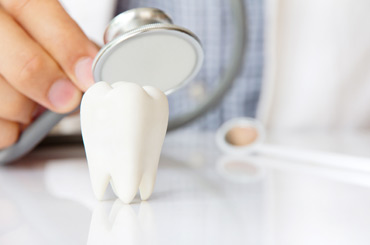Dental and jaw diagnostics
Numerous diseases are related to teeth and jaws
The temporomandibular joint and its capsule apparatus, like the short neck muscles that attach to the head, are up to 100 times more permeated by nerve fibres than other muscles or organs. This is important because mouth movements are very complex and therefore require much finer control than, for example, leg or arm muscles. There are also very close functional connections with the ears and the cervical spine or the entire spine.
One has to imagine that in a disturbed dentition situation there is a constant irritation of the central nervous system, which leads to considerable impairment of the overall coordination. This can be illustrated with an example: If door and door frame do not fit together, the hinges gradually wear out or the door frame and the door no longer function properly. It is the same with a malfunction of the masticatory apparatus. In extreme cases, this can manifest itself as a disease that defies all usual and unusual attempts at therapy.
Due to the current state of knowledge about the architecture and networking of the nervous system, disorders in the chewing area have a paramount influence on all areas of the body and soul (somato-psychic). Therefore, if the described functional disorders are present and lead to disorders in the rest of the body, such as damaged intervertebral discs, headaches, migraines, circulatory disorders in the head, permanent fatigue, etc., this can often be remedied by appropriate diagnostics and therapy. MS (multiple sclerosis) is another very common condition.
Patients with chronic illnesses regularly require or have x-ray findings of the dentition made. They serve to determine whether dead teeth, root remains, inflamed tooth roots or other changes in the dentition can be found. Many diseases are triggered by such findings and they remain resistant to therapy if no remedy is found.




